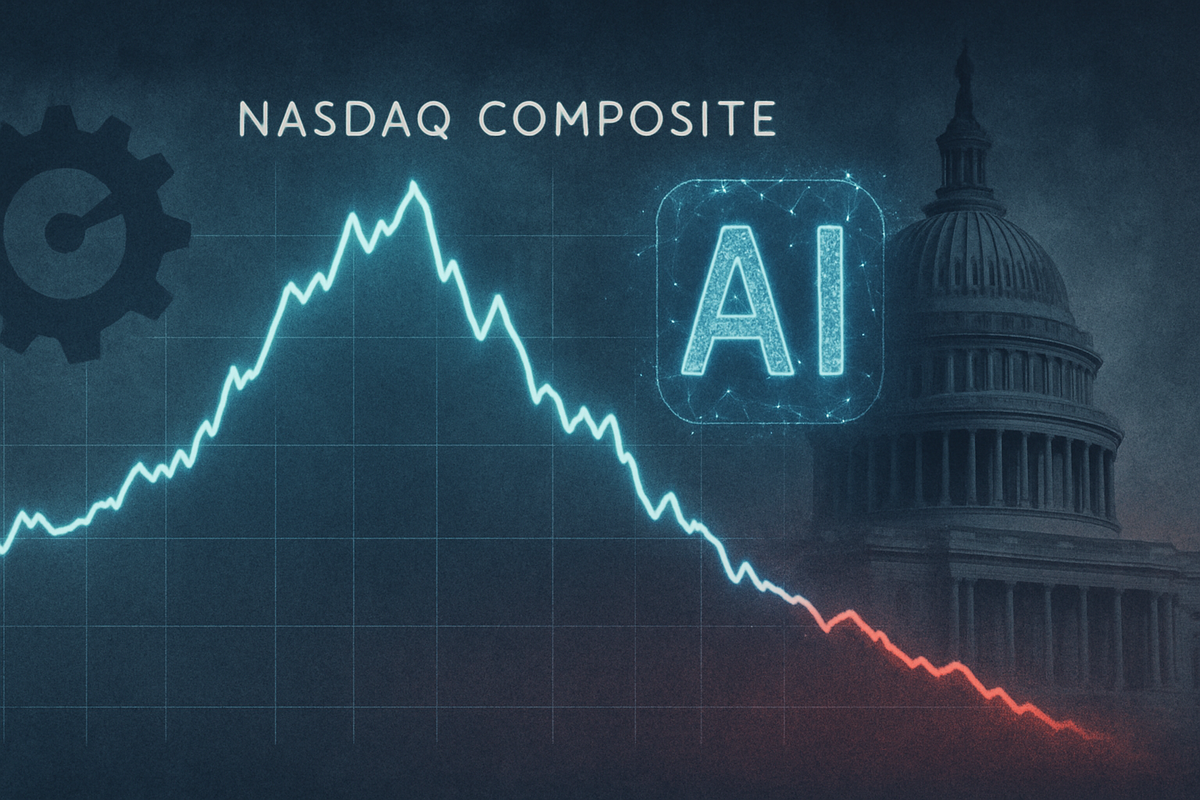
October 9, 2025 – The Nasdaq Composite (NASDAQ) has experienced a notable retreat from its recent all-time record highs, signaling a significant recalibration for financial markets. After surging to an unprecedented intraday peak of 23,062.62 earlier today, October 9, 2025, the tech-heavy index pulled back, ending the day lower. This reversal, following a period of robust gains, is sending ripples through the investment community, prompting a re-evaluation of market fundamentals and the sustainability of growth stock valuations.
This immediate downturn is attributed to a confluence of critical factors, including diminishing expectations for aggressive Federal Reserve interest rate cuts, mounting concerns over potentially inflated valuations within the burgeoning artificial intelligence (AI) sector, and the lingering uncertainty cast by an ongoing US government shutdown. Investors, who had pushed the index into "overbought" territory, are now engaging in profit-taking, shifting focus from growth at all costs to profitability and financial resilience in a landscape of potentially higher borrowing costs.
A Week of Peaks and Pullbacks: The Nasdaq's Recent Volatility
The Nasdaq Composite's recent retreat on October 8th and 9th, 2025, followed a period of exhilarating gains, marking a swift shift in market sentiment. Leading up to this moment, the tech-heavy index, alongside the S&P 500 (NYSEARCA: SPY), had surged to unprecedented levels, fueled by robust optimism for Federal Reserve interest rate cuts and an unyielding enthusiasm for advancements in artificial intelligence. On October 6, 2025, the Nasdaq climbed 0.7% (161.81 points) to 22,941.67, driven by a renewed fervor for AI, including a multi-billion-dollar chip deal between Advanced Micro Devices (NASDAQ: AMD) and OpenAI. The momentum continued, with the Nasdaq reaching an all-time closing high of 23,043.38 on October 8, 2025, and an intraday all-time high of 23,062.62 earlier today, October 9, 2025.
However, the tide began to turn swiftly. By October 8th, the Bank of England issued a cautionary note, warning of a "sudden correction" in global markets, citing soaring valuations of AI tech companies and the potential for a sharp repricing of U.S. dollar assets if the Federal Reserve's credibility waned. This sentiment materialized on October 9, 2025, as U.S. stock markets paused their ascent. The S&P 500 fell 0.3%, the Nasdaq Composite dropped approximately 0.3%, and the Dow Jones Industrial Average (NYSEARCA: DIA) declined 0.4%, or 128 points, by midday. This market shift was primarily driven by a subtle cooling of aggressive Federal Reserve rate cut expectations, mounting concerns over stretched valuations in the tech sector, and an ongoing U.S. government shutdown.
Several interconnected factors converged to trigger this retreat. Firstly, the market's aggressive anticipation of Federal Reserve rate cuts began to wane. While a cut in October 2025 was largely priced in, mixed signals from Fed officials and persistent inflation above target caused traders to re-evaluate the pace and extent of future reductions. Fading hopes for cheaper capital directly impact technology companies, which often rely on readily available and inexpensive funding for expansion. Secondly, growing fears of an "AI bubble" intensified. Technology stocks were trading at 30 times forward earnings estimates, significantly above their long-term average of 21.4. Warnings from institutions like the Bank of England and the International Monetary Fund (IMF) highlighted the risk of a "sharp market correction" due to what some viewed as unsustainable valuations in the leading AI tech companies, drawing comparisons to the dot-com bubble of 2000.
Adding to the uncertainty was an ongoing U.S. government shutdown, entering its second week. This shutdown delayed the release of crucial economic data, such as the September jobs report, hindering market insight and complicating the Federal Reserve's decision-making process. This data vacuum contributed significantly to heightened investor caution. Furthermore, rising bond yields introduced long liquidation pressures, particularly affecting chipmakers, and broader geopolitical uncertainties also contributed to a more circumspect market sentiment. Initial reactions from analysts and investors indicate a reassessment of positions, with many viewing the dip as a necessary digestion of previous gains, but also underscoring underlying vulnerabilities in a market sensitive to monetary policy shifts and valuation scrutiny.
Navigating the Shifting Tides: Winners and Losers in a Recalibrated Market
The Nasdaq's retreat from record highs ushers in a period of intense scrutiny for public companies, particularly those within the technology and growth sectors. The confluence of fading Federal Reserve rate cut hopes, mounting AI valuation concerns, and an ongoing government shutdown creates a challenging environment where some companies will face significant headwinds, while others may demonstrate resilience or even thrive.
Growth-oriented technology stocks, especially those with high valuations and a reliance on future earnings, are likely to be among the primary losers. Tesla (NASDAQ: TSLA), as a rate-sensitive consumer discretionary stock, is vulnerable to higher interest rates dampening consumer demand for electric vehicles; its shares have already seen declines following price cuts. Similarly, Palantir Technologies (NYSE: PLTR), despite its strong AI positioning, faces significant valuation concerns, trading at exceptionally high P/E and PEG ratios. Its stock experienced a notable decline on October 6th, reflecting investor apprehension about its ability to meet lofty growth expectations. Oracle (NYSE: ORCL) also saw a sharp decline after reporting lower-than-expected margins from its AI-related cloud business, sparking fears that profitability challenges could extend to other AI-dependent companies. Even stalwarts of the AI boom like Nvidia (NASDAQ: NVDA) and Advanced Micro Devices (NASDAQ: AMD), while still powerful, are highly exposed to AI valuation concerns; if AI adoption or revenue generation falls short of projections, these stocks could see significant pressure. Smaller, pure-play AI firms such as Aehr Test Systems (NASDAQ: AEHR) and Rigetti Computing (NASDAQ: RGTI), whose valuations are often built on speculative hype rather than current financials, are particularly vulnerable to sharp corrections. Highly leveraged companies across all sectors will also struggle with rising borrowing costs in a higher interest rate environment.
Conversely, companies in more defensive sectors or those with robust financial health are poised to be more resilient, or even emerge as winners. Traditional defensive sectors like Healthcare, Utilities, and Consumer Staples tend to attract capital as investors rotate away from riskier growth assets. The Healthcare Select Sector SPDR (NYSEARCA: XLV) and Utilities Select Sector SPDR (NYSEARCA: XLU) both saw gains on October 6, 2025. Companies like Procter & Gamble (NYSE: PG) in consumer staples and NextEra Energy (NYSE: NEE) in utilities could see increased interest. Firms with strong fundamentals, healthy cash flows, and less debt, such as Berkshire Hathaway (NYSE: BRK.A, BRK.B), Visa (NYSE: V), and Costco Wholesale Corp. (NASDAQ: COST), are better equipped to weather economic uncertainties and higher borrowing costs. Select financial institutions, like JPMorgan Chase (NYSE: JPM), may also benefit from rising net interest margins in a higher interest rate environment. Furthermore, companies that can demonstrate proven, profitable AI applications, rather than just speculative potential, may still thrive. SoundHound AI (NASDAQ: SOUN), with its significant stock growth driven by real-world AI applications and strong revenue, stands out. Dell Technologies (NYSE: DELL) also reported gains after highlighting its AI-related growth opportunities, as did Poet Technologies, which secured investment for high-speed optical engines used in AI systems.
A Broader Recalibration: Industry Shifts, Ripple Effects, and Historical Echoes
The Nasdaq Composite's retreat from record highs on October 8-9, 2025, is more than just a momentary dip; it signifies a broader recalibration of financial markets and a potential inflection point for the technology sector. This downturn, fueled by cooling Federal Reserve rate cut hopes, elevated AI valuation concerns, and the impact of an ongoing government shutdown, carries profound implications for industry trends, competitors, partners, regulatory bodies, and draws notable historical comparisons.
Broader Industry Trends: This event signals a significant shift in investor sentiment, moving from unbridled optimism and growth speculation to a more cautious and scrutinizing environment, particularly within the technology sector. The preceding surge, driven by anticipated Fed rate cuts and fervent AI enthusiasm, has given way to a re-evaluation of equity risks, especially for rate-sensitive growth stocks with high valuations. Within the tech industry, this could intensify pressure on companies to prioritize financial stability over aggressive innovation, potentially leading to a deceleration in new projects and a greater focus on cost control. This environment may also trigger increased competition for fewer job openings, salary stagnation, and delayed career progression for tech professionals, as capital rotates towards more fundamentally sound value stocks.
Potential Ripple Effects on Competitors and Partners: The heavily technology-weighted Nasdaq 100's downturn could create substantial ripple effects throughout the interconnected tech ecosystem. Smaller competitors and startups, many of whom rely on venture capital and private equity, could face a repricing of their valuations, making fundraising significantly more challenging and potentially leading to "down rounds" or even bankruptcies. Companies reliant on readily available and cheaper capital for expansion will be directly impacted by higher borrowing costs. Furthermore, the highly integrated nature of the tech supply chain means that a correction in mega-cap technology companies—often dubbed the "Magnificent Seven"—could have profound impacts on their vast network of suppliers, partners, and customers. Conversely, firms providing essential infrastructure for AI, rather than just speculative applications, might find renewed interest as investors seek more tangible business models. Globally, a US-led market correction would likely send shockwaves through international markets, with emerging markets being particularly vulnerable.
Regulatory or Policy Implications: A significant market downturn could intensify calls for increased regulatory scrutiny, particularly concerning speculative activities within the AI sector. Concerns about market stability or potential speculative bubbles could pressure central banks and governments to consider new stimulus measures, though their tools might be constrained if inflation remains a persistent concern. Regulatory compliance plays a pivotal role in maintaining market stability, and in periods of heightened volatility, regulators may implement measures such as adjusting margin requirements or initiating circuit breakers. However, an ongoing government shutdown complicates this by disrupting the release of vital economic data, leaving investors and policymakers, including the Federal Reserve, with less information for decision-making and potentially amplifying market volatility. This lack of data could leave investors "flying blind," exacerbating uncertainty.
Historical Precedents and Comparisons to Similar Events: The current market concentration and high valuations in the tech sector, especially those fueled by AI enthusiasm, draw significant comparisons to the dot-com bubble of 2000-2002. During that period, the Nasdaq Composite Index experienced a nearly 78% decline, leading to the failure of numerous unprofitable startups. While many of today's leading tech giants are generally profitable, the speculative nature and stretched valuations of some AI investments, with some metrics comparable to the dot-com bubble's peak, raise concerns about a potential "AI-driven bubble." Historically, market pullbacks are not uncommon, with 60 corrections (declines of 10% or more) since 1928. While the tech industry has shown resilience and recovered faster than other sectors after past downturns, such as the 2008 financial crisis, the current unique combination of factors—tightening monetary conditions, speculative AI valuations, and political gridlock—merits careful consideration and suggests a demand for concrete profitability and sustainable business models.
The Road Ahead: Navigating Volatility and Seeking Sustainable Growth
The Nasdaq Composite's recent retreat from record highs ushers in a period of heightened uncertainty and strategic re-evaluation for both companies and investors. The interplay of cooling Fed rate cut expectations, persistent AI valuation concerns, and the lingering government shutdown will shape the immediate and long-term outlook for growth stocks and the broader market.
Short-Term Possibilities: In the immediate aftermath, markets are expected to remain volatile, with further pullbacks remaining a distinct possibility. Investors should anticipate a continued rotation of capital away from high-growth, speculative tech stocks towards more defensive, value-oriented sectors such as energy, healthcare, and consumer staples. While government shutdowns historically have a minor and temporary impact on the broader economy, a prolonged shutdown could exacerbate economic risks and further weigh on market sentiment by delaying crucial economic data. However, for astute long-term investors, minor dips after significant gains can often present strategic buying opportunities in fundamentally strong companies. The market's sensitivity to Federal Reserve policy shifts and the intense scrutiny of tech valuations will remain paramount.
Long-Term Possibilities: Looking towards 2026 and beyond, the underlying drivers of digital transformation, AI innovation, and cloud computing are expected to continue shaping the tech landscape. The focus, however, will likely shift from mere AI experimentation to demonstrating tangible business value and measurable return on investment. There are encouraging signs that the bull market, which commenced in October 2022, is broadening beyond just the "Magnificent 7" tech giants, with small-cap stocks, cyclical sectors, and even healthcare beginning to participate. This broadening suggests a deeper and potentially more sustainable foundation for overall market growth. Nevertheless, concerns about an "AI bubble" persist, and a significant correction could force companies to prioritize profitability and sustainable business models over purely speculative valuations, ultimately leading to a healthier and more resilient tech sector in the long run.
Potential Strategic Pivots and Adaptations: For companies, the imperative will be to prioritize efficiency, profitability, and prudent capital allocation. This includes leading by example in adopting AI-first systems internally, exploring new revenue streams, and diversifying supply chains and operations to build resilience against geopolitical and economic headwinds. Companies with robust fundamentals, strong cash flows, and less reliance on debt will be better positioned to weather economic storms. For investors, a pivot towards active management strategies may become more effective in navigating increased volatility. Opportunities may emerge in resilient companies with strong fundamentals, particularly those genuinely leveraging AI for transformative growth. Increased selectivity in growth stock investments and a focus on intrinsic value will be crucial, with some analysts recommending consideration of small-cap and value stocks as potential "bastions of value" during this period.
Market Opportunities and Challenges: Opportunities may arise in undervalued growth stocks, specific tech sub-sectors like cybersecurity (where spending is often non-negotiable), and through diversification into real estate, energy, and healthcare, which can act as buffers against tech-heavy volatility. However, significant challenges loom. Persistent valuation concerns, particularly for AI-focused technology companies, remain a key risk, with some valuations appearing comparable to the dot-com bubble peak. Interest rate sensitivity will continue to impact tech companies reliant on cheaper capital. The specter of an economic slowdown or recession, potentially coupled with a deflating AI bubble and struggling consumers, could trigger a more significant market decline. Furthermore, increased regulatory scrutiny and ongoing geopolitical tensions could create additional headwinds. The Bank of England has also warned that a sharp drop in valuations could occur if AI's progress or adoption proves disappointing, or if material bottlenecks in power, data, or commodity supply chains emerge.
Potential Scenarios and Outcomes: Several scenarios could unfold. A "soft landing" might see a healthy, albeit sharp, market correction followed by continued growth, where a rebalancing of market leadership fosters a more sustainable growth environment. Conversely, a "prolonged downturn/bear market" could materialize if a deflating AI bubble combines with a broadly slowing economy, potentially leading to a significant S&P 500 decline that could take years to recover. A "volatile consolidation and sector rotation" scenario suggests continued market volatility without a clear direction, with investors actively rotating between sectors. Finally, a "broadening bull market" could still emerge if small-cap and cyclical stocks continue to gain momentum, leading to a more sustainable market rally.
Conclusion: Navigating a New Market Paradigm
The Nasdaq Composite's retreat on October 8-9, 2025, serves as a critical reminder of the market's inherent volatility and its sensitivity to macroeconomic shifts and speculative fervor. This event encapsulates a pivotal transition: a move away from an era defined by readily available cheap capital towards one where profitability, robust cash flow, and financial resilience are paramount. While the underlying technological advancements, particularly in AI, remain genuine and transformative, the market's reaction signals that sustainable growth and tangible returns, rather than speculative hype, will be increasingly scrutinized.
The current market environment presents a complex interplay of innovation, speculation, and underlying risk, with undeniable signs of overvaluation, especially within the AI sector. The lasting impact of this retreat will largely hinge on how effectively the underlying concerns—cooling Fed rate expectations, AI valuation excesses, and the government shutdown—are addressed. A prolonged period of "stretched" valuations in tech, particularly AI, makes the market "particularly exposed should expectations around the impact of AI become less optimistic."
What Investors Should Watch For in Coming Months: Investors should exercise extreme caution and prioritize fundamental analysis over speculative trends. Key areas to monitor include:
- Federal Reserve Communications and Economic Data: Any shifts in the Fed's stance on interest rates, inflation trends, and employment figures will be crucial. The resumption of economic data releases after the government shutdown will be vital for guiding monetary policy decisions.
- Corporate Earnings Reports: The upcoming third-quarter corporate earnings season will provide critical insights into the actual performance of companies, especially those in the tech and AI sectors. Companies demonstrating strong fundamentals and a clear path to profitability in their AI ventures will show greater resilience.
- AI Sector Developments: Scrutinize the actual return on investment (ROI) from generative AI projects. Be wary of companies with exorbitant valuations primarily driven by future growth expectations rather than current profitability, particularly smaller, pure-play AI firms.
- Resolution of the Government Shutdown: A swift resolution would remove one layer of uncertainty, though a prolonged shutdown could lead to accumulating economic risks.
- Geopolitical Developments: Broader geopolitical events and trade discussions can also influence U.S. markets and should be closely watched.
The current market environment, characterized by record highs in major indices driven by AI enthusiasm, indicates a "speculative frenzy" and a potential "AI bubble." While technological advancements are genuine, the disconnect between soaring stock prices and underlying economic realities, coupled with a highly concentrated market, suggests that a significant correction is not just possible, but increasingly probable. Investors may find opportunities in resilient companies with strong fundamentals that are genuinely leveraging AI for transformation and growth, and potentially in undervalued sectors that emerge from a market correction.
This content is intended for informational purposes only and is not financial advice







